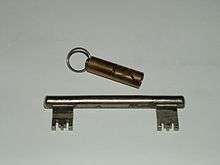Berlin key

The Berlin key (also known as, German, Schließzwangschlüssel, or, English, forced locking key) is a key for a type of door lock. It was designed to force people to close and lock their doors (usually a main entrance door or gate leading into a common yard or tenement block). Its particularity comes from the fact that it has two key blades (the part which activates the bolt), one at each end of the key, rather than the usual single blade. After unlocking the lock, the key must be pushed all the way through the lock and retrieved on the other side of the door after it has been closed and locked again. The mechanism makes the retrieval of the key impossible when the door is unlocked. Also, locking an open door is usually not possible.
Invented by the Berliner locksmith Johannes Schweiger,[1] the Berlin key was massively produced by the Albert Kerfin & Co company starting in 1912.[2] With the advent of more recent locking technologies, this kind of lock and key is becoming less common, but it can still be widely found in the tenement buildings of Berlin, Germany.
The key is subject of the book The Berlin Key by Science and Technology studies professor Bruno Latour.
References
- ↑ Ullmann, Petra (8 March 2000). "Vor fast 90 Jahren erfand ein Weddinger Handwerker den Durchsteckschlüssel" (in German). Der Tagesspiegel. Retrieved 19 August 2013.
- ↑ Sethmann, Jens (November 2005). "Der Siegeszug des Doppelschlüssels" (in German). MieterMagazin. Retrieved 19 August 2013.